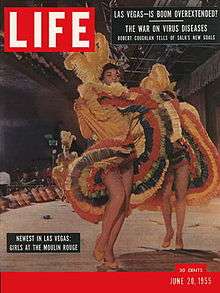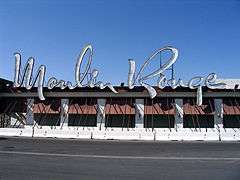Moulin Rouge Hotel
|
Moulin Rouge Hotel | |
|
Moulin Rouge sign, c. 2006 | |
  | |
| Location |
900 West Bonanza Road Las Vegas, Nevada |
|---|---|
| Nearest city | Las Vegas, Nevada |
| Coordinates | 36°10′42″N 115°09′13″W / 36.17833°N 115.15361°WCoordinates: 36°10′42″N 115°09′13″W / 36.17833°N 115.15361°W |
| Architect | Zick & Sharp |
| Architectural style | "Googie-populuxe" Modernist |
| NRHP Reference # | 92001701 |
| Added to NRHP | 1992 |
The Moulin Rouge Hotel was a hotel and casino located in the West Las Vegas neighborhood of Las Vegas, Nevada, that is listed on the United States National Register of Historic Places. The first desegregated hotel casino, it was popular with many of the black entertainers of the time, who would entertain at the other hotels and casinos and stay at the Moulin Rouge.
Early history

The Moulin Rouge opened on May 24, 1955, built at a cost of $3.5 million.[1] It was the first integrated hotel casino in the United States.[1] Until that time almost all of the casinos on the Strip were totally segregated—off limits to blacks unless they were the entertainment or labor force.
Characteristic
The hotel was located in West Las Vegas, where the black population lived. West Las Vegas was bounded by Washington Avenue on the north, Bonanza Road on the south, H Street on the west, and A Street on the east. The establishment was a model of eye-catching, 110 rooms, a gorgeous showroom, swimming pool, restaurant/coffee shop, dress-shop, and bar which was constructed of highly polished and expensive hardwoods.
References to Paris are numerous:
- The Eiffel Tower appears vertically on the sign of the establishment, and also on the casino chips,
- A French Chef is at the head of the largest gastronomic restaurant of the establishments
- From the entrance, security personnel are dressed in the uniform of the French Foreign Legion (allusion to France and Edith Piaf, who made a comeback after the war with Yves Montand at the Moulin Rouge), which, according to the press, adds a touch of glamour in Las Vegas.
Founding
It was during this era that Will Max Schwartz saw the need for an integrated hotel. Will, along with other white investors—Louis Rubin, owner of Chandler's Restaurant in New York City, and Alexander Bisno, who worked in real estate in California—and black boxing great Joe Louis, built and opened the Moulin Rouge at 900 West Bonanza Road. This location placed it in a prime location between the predominantly white area of the Strip and the largely black west side.
Design
The complex itself consisted of two "Googie-populuxe" Modernist style stuccoed buildings that housed the hotel, the casino, and a theater. The exterior had the hotel's name in stylized cursive writing and murals depicting dancing and fancy cars. The sign was designed by Betty Willis, creator of the "Welcome to Las Vegas" sign on the south end of the Strip. The Moulin Rouge in Paris was a source of inspiration. When the casino opened the revue "Tropi Cancan," was inspired by the French Cancan, created in the 19th century to the Moulin Rouge Paris: «The Moulin Rouge Hotel and Casino opened on May 24, 1955 to fanfare, long lines of well-dressed visitors, and Las Vegas' newest showroom revue, the Tropi-Can-Can Revue» This inspiration comes from the first Afro-American star in France, Josephine Baker. The wall painted of the Moulin Rouge Las Vegas, included many references to Paris and Toulouse-Lautrec. “Black showgirls performed on a stage amid a backdrop of walls featuring mahogany wood trim and Toulouse-Lautrec-style murals of black French cancan dancers. The showroom featured "Tropi-Can-Can" under the tutelage of veteran producer Clarence Robinson.”
Operating and direction
When it opened, the Moulin Rouge was fully integrated top to bottom, from employees to patrons to entertainers.
The hotel made the June 20, 1955, cover of Life magazine, with a photo of two showgirls. A veritable "A" list of performers regularly showed to party until dawn. Great black singers and musicians such as Lena Horne, Sammy Davis Jr., Louis Armstrong, Sarah Vaughan, Nat King Cole, Duke Ellington, Dorothy Dandridge, Harry Belafonte, Pearl Bailey, and Count Basie would perform often. These artists were banned from gambling or staying at the hotels on the Strip.[1] In addition, white performers, including George Burns, Jeanette MacDonald, Tallulah Bankhead, Judy Garland, Marlene Dietrich, Frankie Laine, Maurice Chevalier, Zsa Zsa Gabor, Jack Benny, Sophie Tucker and Frank Sinatra, would drop in after their shows to gamble and perform. Eventually management added a 2:30am "Third Show" to accommodate the crowds.
Closure and landmarking
In November 1955 the Moulin Rouge closed its doors, and by December 1955, the casino had declared bankruptcy.[1] Nevertheless, to maintain its gaming license, the Moulin Rouge (like many closed properties) operates on a temporary basis for a state-mandated minimum of eight hours every two years,[2] most recently on June 19, 2012[3] and on June 11, 2014.[4][5]
Civil-rights heritage
The short but vibrant life of the Moulin Rouge helped the civil-rights movement in Las Vegas. For a while the hotel was owned by the first African American woman to hold a Nevada Gaming License, Sarann Knight-Preddy. Many of those who enjoyed and were employed by the hotel became activists and supporters. The hotel was also the spark needed to bring an end to segregation on the Strip.
In 1960, under threat of a protest march down the Las Vegas Strip against racial discrimination by Las Vegas casinos, a meeting was hurriedly arranged by then-Governor Grant Sawyer between hotel owners, city and state officials, local black leaders, and then-NAACP president Dr. James McMillan. The meeting was held on March 26 at the closed Moulin Rouge. This resulted in an agreement to desegregate all Strip casinos. Hank Greenspun, who would become an important media figure in the town, mediated the agreement.
In 1992 the building was listed on the National Register of Historic Places and became a symbol of the expanding of black civil rights, and a monument of Las Vegas’s racist past.
Preservation and fires
Although the Moulin Rouge complex remained shuttered for decades, many plans had been hatched to rebuild and reopen the cultural landmark. But on May 29, 2003, a fire ripped through the buildings, almost entirely gutting the complex.[6] The facade with its signature stylized name was spared destruction. In 2004, a man arrested near the property was sentenced to four years in prison after pleading guilty to one count of arson in connection with the fire.[7]
January 2004 saw the Moulin Rouge sold again for $12.1 million to the Moulin Rouge Development Corporation. The stylized "Moulin Rouge" neon sign was turned back on.[8] A $200 million renovation of the site was announced but was never completed.
Following a February decision to tear down the structures as a public nuisance, the third fire in four years on May 6, 2009, caused significant damage to the original hotel lobby building, but did not touch the remaining original exterior wall that held the signage. The signage had just been removed for storage at the Neon Museum boneyard.[9] The property, which was in foreclosure at the time of the fire, had failed to sell at a foreclosure auction the day before.[9]
In June, 2010, the Las Vegas Historic Preservation Commission approved permits for demolition of the remains of the buildings, citing numerous concerns by the city about the safety of the structures. Instead of demolishing what was left of the hotel wings, which had seemed to catch fire every few years, the city instead demolished the stone exterior wall, pillar, and facade that held the sign. Also destroyed was the landmark tower that stood over the West side and was a symbol to the residents. The tower, which the city claimed was unstable, took nearly half a day of weakening to finally pull down. As of February 2011, the red mosaic pillars still lie in the empty lot, and the unstable, fire hazard hotel wings still stand.[10]
Gambling occurs on site every two years (via video poker machines which are trucked in for a day) to maintain the gaming license, which remains active although the casino has otherwise been out of business for 60 years.[11]
Sources
- We Shall Overcome - Moulin Rouge
- Las Vegas Centennial 1905:2005
- African American History in the West Vignette: The Moulin Rouge
- Hidden histories
- Former Showgirl Recalls Working at Moulin Rouge
References
- 1 2 3 4 "MOULIN ROUGE'S HISTORY". Moulin Rouge Museum & Cultural Center. Retrieved 2010-03-28.
- ↑ Powers, Ashley (2008-09-23). "Casino stays in the game for a day". Los Angeles Times. Retrieved 2012-05-09.
- ↑ Sylvester, Ron (2012-06-19). "Pop-up casino opens for 8 hours at former Moulin Rouge". Vegas Inc. Las Vegas Sun. Retrieved 22 June 2012.
- ↑ Schoenmann, Joe (2014-05-21). "Gambling returns to old Moulin Rouge — for a day". Las Vegas Sun. Retrieved 2014-11-10.
- ↑ "Pop-Up Casino at Former Moulin Rouge is Awesome, Announcement of New Moulin Rouge, Not So Much". VitalVegas.com. Retrieved 2014-11-10.
- ↑ "Moulin Rouge Fire". article index for Moulin Rouge fire. Las Vegas Review-Journal. Retrieved 2007-05-03.
- ↑ "UPDATE: Man sentenced to more than four years in prison for role in Moulin Rouge fire". Las Vegas Review-Journal. Retrieved 2009-05-06.
- ↑ Squires, Michael (2004-01-29). "'FROM ITS ASHES': Group buys historic site". Las Vegas Review-Journal. Retrieved 2007-05-03.
- 1 2 "Historic Moulin Rouge Burns". KLAS-TV. Retrieved May 6, 2009.
- ↑ Choate, Alan (2010-06-23). "'Owners get approval for Moulin Rouge demolition'". Las Vegas Review-Journal. Archived from the original on June 24, 2010. Retrieved 2010-06-23.
- ↑ Cook, Kevin (2013-01-01). "'The Vegas Hotspot That Broke All the Rules'". Smithsonian Magazine. Retrieved 2016-08-12.

